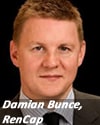Renaissance Capital’s electronic trading group CEO Damian Bunce says the prospective takeover of the emerging markets-focused investment bank by Onexim will let the firm tap into capital to support its trading ambitions.
Onexim Group, the investment vehicle owned by Russian oligarch Mikhail Prokhorov, agreed a deal to purchase the remaining shares of Renaissance Capital it did not already own in November. The deal is still awaiting final sign off from the Russian government and regulators.
The change in ownership structure will help to bolster capital intensive trading activity that RenCap offers to institutional buy-side and proprietary trading clients, according to Bunce, who joined the firm in November 2011 from his role as head of electronic trading distribution for Europe at Barclays Capital.
“If the deal goes through, Renaissance Capital will be wholly-owned by a highly-respected, very wealthy entity that has the ability to provide us with funding, an issue that some Russian institutions struggle with,” Bunce told theTRADEnews.com. “The Onexim backing will help us support balance sheet intensive activities like global depository receipt (GDR) conversion trades for arbitrage clients as well as allowing us to continue investing in our high-speed trading infrastructure.”
Conversion trades are popular with high-frequency trading firms that arbitrage price differences between stocks listed on the Moscow Exchange – formed through the recent merger of RTS and MICEX – and the GDR equivalents listed on the London Stock Exchange’s International Order Book.
RenCap has spent heavily in low-latency trading software, such as its deal with financial software firm GATELab that offers market access in under 130 microseconds, and has developed cross-margining capabilities that allow clients to reduce the margin across correlated instruments.
These attributes, combined with the block-sized flow the broker receives from institutional clients, will help the investment bank grab more high-frequency trading clients, believes Bunce.
“All types of foreign investor see Russia as an accessible emerging market as there is no stamp tax, no value-added tax on brokerage commissions, no barriers to entry for international firms compared to domestic firms like some BRIC countries, and healthy liquidity,” he said, adding there are currently 30-35 domestic and international high-frequency trading firms operating in Russia. “Some of the biggest HFT firms are starting to make their presence felt in Russia and this will increase as market structure continues to evolve.”
As well as further promoting Moscow as a financial hub, the MICEX-RTS merger will also lead to a number of market structure changes that will make it easier for international firms to access Russian liquidity.
This includes the transformation of the National Settlement Depository into a central securities depository, improving transparency and settlement finality, the move to T+n settlement, the implementation of a new cross-asset trading platform at the Moscow Exchange.
